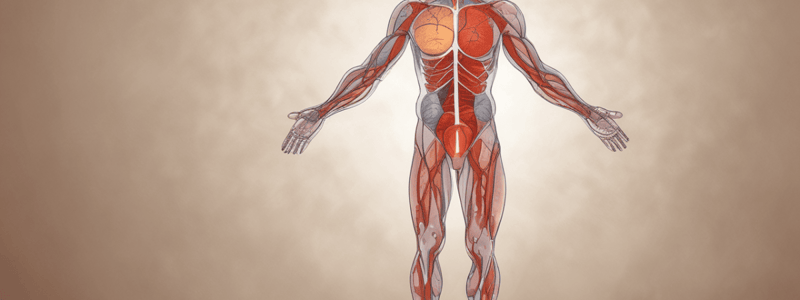Podcast
Questions and Answers
What is the term for the point where two blood vessels merge?
What is the term for the point where two blood vessels merge?
- Anastomosis (correct)
- Precapillary sphincter
- Thoroughfare channel
- Metarteriole
What is the function of precapillary sphincters in capillary beds?
What is the function of precapillary sphincters in capillary beds?
- To control which beds are well perfused (correct)
- To regulate blood pressure
- To increase blood flow to the heart
- To decrease oxygen delivery to the muscles
What is the term for the blood vessel that continues through the capillary bed to the venule?
What is the term for the blood vessel that continues through the capillary bed to the venule?
- Arteriole
- Metarteriole
- Venule
- Thoroughfare channel (correct)
What is the term for the connection between an arteriole and a venule?
What is the term for the connection between an arteriole and a venule?
What is the term for a network of capillaries?
What is the term for a network of capillaries?
What is the term for a blood vessel that supplies a capillary bed?
What is the term for a blood vessel that supplies a capillary bed?
Which of the following vessels carries oxygenated blood from the lungs to the left side of the heart?
Which of the following vessels carries oxygenated blood from the lungs to the left side of the heart?
Which part of the heart receives lesser oxygenated blood from the inferior and superior venae cavae?
Which part of the heart receives lesser oxygenated blood from the inferior and superior venae cavae?
What is the primary function of the pulmonary circuit?
What is the primary function of the pulmonary circuit?
What is the main difference between the oxygen-rich blood and oxygen-poor blood in the circulatory system?
What is the main difference between the oxygen-rich blood and oxygen-poor blood in the circulatory system?
Which of the following is a risk factor for cardiopulmonary conditions?
Which of the following is a risk factor for cardiopulmonary conditions?
What is the term for the innermost layer of a blood vessel that is exposed to blood?
What is the term for the innermost layer of a blood vessel that is exposed to blood?
Which of the following is a complication of cardiopulmonary conditions that must be accounted for when applying exercise interventions?
Which of the following is a complication of cardiopulmonary conditions that must be accounted for when applying exercise interventions?
What is the primary function of the systemic circuit?
What is the primary function of the systemic circuit?
What is the primary function of the endothelium in the cardiovascular system?
What is the primary function of the endothelium in the cardiovascular system?
Which of the following is a complication that must be accounted for when applying exercise interventions to individuals with cardiopulmonary conditions?
Which of the following is a complication that must be accounted for when applying exercise interventions to individuals with cardiopulmonary conditions?
What is the role of shear stress in the cardiovascular system?
What is the role of shear stress in the cardiovascular system?
Which of the following is a risk factor for cardiovascular disease that must be considered when applying exercise interventions?
Which of the following is a risk factor for cardiovascular disease that must be considered when applying exercise interventions?
What is the primary function of the right and left atria (auricles) in the cardiovascular system?
What is the primary function of the right and left atria (auricles) in the cardiovascular system?
What is the pathophysiological underpinning of the importance of exercise in the management of cardiovascular conditions?
What is the pathophysiological underpinning of the importance of exercise in the management of cardiovascular conditions?
Which of the following is a co-morbidity that must be accounted for when applying exercise interventions to individuals with cardiopulmonary conditions?
Which of the following is a co-morbidity that must be accounted for when applying exercise interventions to individuals with cardiopulmonary conditions?
What is the role of the conduction system in the cardiovascular system?
What is the role of the conduction system in the cardiovascular system?
Study Notes
Cardiovascular System Refresher
- The heart has 4 chambers: right and left atria (auricles) and right and left ventricles
- The pulmonary circuit carries blood to the lungs for gas exchange and back to the heart
- The systemic circuit supplies oxygenated blood to all tissues of the body and returns it to the heart
- Blood flows from the right side of the heart to the lungs and from the left side of the heart to the rest of the body
Circulatory System
- The tunica interna (tunica intima) lines the blood vessel and is exposed to blood
- Endothelium covers the inner surface of blood vessels
- Capillaries are organized into networks called capillary beds
- Precapillary sphincters control which beds are well perfused
- Thoroughfare channels are metarterioles that continue through capillary beds to venules
- Anastomosis is the point where two blood vessels merge
Prevalence of Cardiovascular Disease in Australia
- Cardiovascular disease is a significant health issue in Australia
- The prevalence of cardiovascular disease in Australia is high and requires attention
Pathophysiological Underpinnings
- Endothelial dysfunction is a key factor in cardiovascular conditions
- Nitric oxide plays a crucial role in cardiovascular health
- Inflammation is a critical component of cardiovascular disease
- Shear stress is another important factor in cardiovascular health
Studying That Suits You
Use AI to generate personalized quizzes and flashcards to suit your learning preferences.
Related Documents
Description
Learn about the Cardiovascular System and its components, including the role of exercise in maintaining a healthy heart. This quiz is based on the Week 1 Lecture 2A of EHR519 course.




